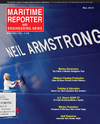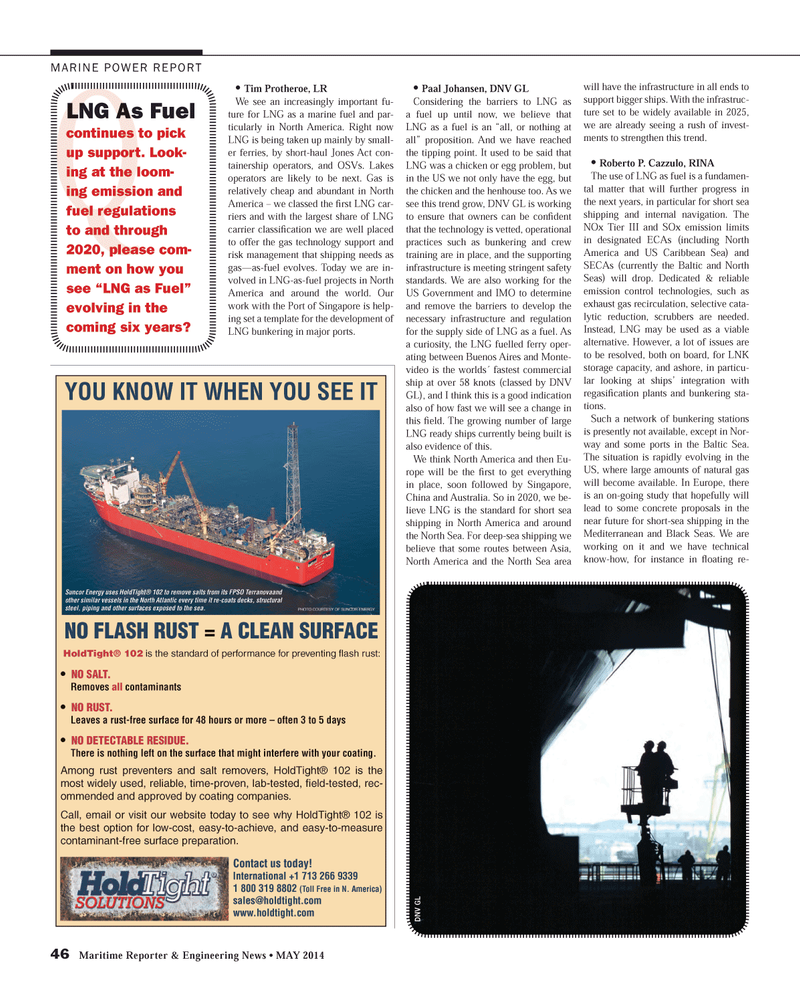
Page 46: of Maritime Reporter Magazine (May 2014)
Marine Electronics Edition
Read this page in Pdf, Flash or Html5 edition of May 2014 Maritime Reporter Magazine
46 Maritime Reporter & Engineering News • MAY 2014
Q
MARINE POWER REPORT Tim Protheroe, LR
We see an increasingly important fu- ture for LNG as a marine fuel and par- ticularly in North America. Right now
LNG is being taken up mainly by small- er ferries, by short-haul Jones Act con- tainership operators, and OSVs. Lakes operators are likely to be next. Gas is relatively cheap and abundant in North
America – we classed the fi rst LNG car- riers and with the largest share of LNG carrier classifi cation we are well placed to offer the gas technology support and risk management that shipping needs as gas—as-fuel evolves. Today we are in- volved in LNG-as-fuel projects in North
America and around the world. Our work with the Port of Singapore is help- ing set a template for the development of
LNG bunkering in major ports. Paal Johansen, DNV GL
Considering the barriers to LNG as a fuel up until now, we believe that
LNG as a fuel is an “all, or nothing at all” proposition. And we have reached the tipping point. It used to be said that
LNG was a chicken or egg problem, but in the US we not only have the egg, but the chicken and the henhouse too. As we see this trend grow, DNV GL is working to ensure that owners can be confi dent that the technology is vetted, operational practices such as bunkering and crew training are in place, and the supporting infrastructure is meeting stringent safety standards. We are also working for the
US Government and IMO to determine and remove the barriers to develop the necessary infrastructure and regulation for the supply side of LNG as a fuel. As a curiosity, the LNG fuelled ferry oper- ating between Buenos Aires and Monte- video is the worlds´ fastest commercial ship at over 58 knots (classed by DNV
GL), and I think this is a good indication also of how fast we will see a change in this fi eld. The growing number of large
LNG ready ships currently being built is also evidence of this.
We think North America and then Eu- rope will be the fi rst to get everything in place, soon followed by Singapore,
China and Australia. So in 2020, we be- lieve LNG is the standard for short sea shipping in North America and around the North Sea. For deep-sea shipping we believe that some routes between Asia,
North America and the North Sea area will have the infrastructure in all ends to support bigger ships. With the infrastruc- ture set to be widely available in 2025, we are already seeing a rush of invest- ments to strengthen this trend. Roberto P. Cazzulo, RINA
The use of LNG as fuel is a fundamen- tal matter that will further progress in the next years, in particular for short sea shipping and internal navigation. The
NOx Tier III and SOx emission limits in designated ECAs (including North
America and US Caribbean Sea) and
SECAs (currently the Baltic and North
Seas) will drop. Dedicated & reliable emission control technologies, such as exhaust gas recirculation, selective cata- lytic reduction, scrubbers are needed.
Instead, LNG may be used as a viable alternative. However, a lot of issues are to be resolved, both on board, for LNK storage capacity, and ashore, in particu- lar looking at ships’ integration with regasifi cation plants and bunkering sta- tions.
Such a network of bunkering stations is presently not available, except in Nor- way and some ports in the Baltic Sea.
The situation is rapidly evolving in the
US, where large amounts of natural gas will become available. In Europe, there is an on-going study that hopefully will lead to some concrete proposals in the near future for short-sea shipping in the
Mediterranean and Black Seas. We are working on it and we have technical know-how, for instance in fl oating re-
YOU KNOW IT WHEN YOU SEE IT
Suncor Energy uses HoldTight® 102 to remove salts from its FPSO Terranovaand other similar vessels in the North Atlantic every time it re-coats decks, structural steel, piping and other surfaces exposed to the sea.
NO FLASH RUST = A CLEAN SURFACE
HoldTight® 102 is the standard of performance for preventing flash rust: �s NO SALT. Removes all contaminants �s NO RUST. Leaves a rust-free surface for 48 hours or more – often 3 to 5 days �s NO DETECTABLE RESIDUE. There is nothing left on the surface that might interfere with your coating.
Among rust preventers and salt removers, HoldTight® 102 is the most widely used, reliable, time-proven, lab-tested, field-tested, rec- ommended and approved by coating companies.
Call, email or visit our website today to see why HoldTight® 102 is the best option for low-cost, easy-to-achieve, and easy-to-measure contaminant-free surface preparation.
Contact us today!
International +1 713 266 9339 1 800 319 8802 (Toll Free in N. America) [email protected] www.holdtight.com
LNG As Fuel continues to pick up support. Look- ing at the loom- ing emission and fuel regulations to and through 2020, please com- ment on how you see “LNG as Fuel” evolving in the coming six years?
DNV GL
MR #5 (42-49).indd 46 5/1/2014 12:13:37 PM

 45
45

 47
47
